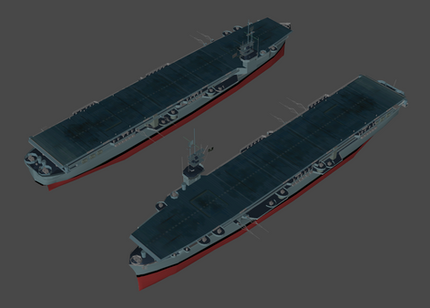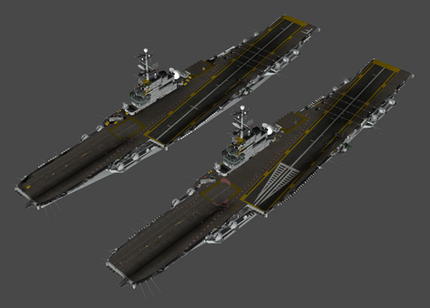HOME | DD
 DigitalExplorations — USN - Essex class carrier SCB-125 LP (MSFS/CFS2)
DigitalExplorations — USN - Essex class carrier SCB-125 LP (MSFS/CFS2)

Published: 2020-09-28 22:43:28 +0000 UTC; Views: 4985; Favourites: 42; Downloads: 52
Redirect to original
Description
Ported to OBJ from the CG model created for use with the Microsoft Flight Simulator (MSFS) and Microsoft's Combat Flight Simulator (CFS) series of games by "JMK" of the original MSFS Virtual Navy team. Preview picture posed in XNALara XPS. NO MODEL DOWNLOAD.
Between 1954 and 1959 the United States Navy (USN) conducted a second series of major upgrades to most of its large fleet of World War II era Essex class fleet aircraft carriers which was intended to keep them operational through the 1960s and perhaps beyond. These are know collectively as SCB-125 in USN nomenclature. All of the ships that got the earlier SCB-27 series upgrade were upgraded to the new SCB-125 spec save one (Lake Champlain). While there were minor differences with each upgraded SCB-125 Essex given the way their refits went, all of them could be easily distinguished from a non-upgraded Essex by their enclosed hurricane bows and angled flight decks. Fourteen Essex class carriers were eventually upgraded to the SCB-125 standard, and it most definitely extended their service lives. All served well into the Vietnam War era (late 1960s to mid-1970s), but after that all were decommissioned save for Lexington (CV-16 and later AVT-16), which would serve until 1991 as the U.S. Navy's lone training carrier (and also become the longest-lived Essex in active military service). This was a necessary move due both to their age and increasing inability to operate more modern and jet aircraft (such the F-4 Phantom II and later both the F-14 Tomcat and F/A-18 Hornet) as the years rolled*. Even so, four were kept in reserve through the rest of the 1970s and well into the 1980s (Hornet, Bon Homme Richard, Shangri-La, and Oriskany), obstensibly to serve as parts ships to keep Lexington operational but ready to be reactivated (most likely as secondary carriers or simply as ready aircraft ferries) in case the Cold War ever turned hot. Initial plans by the Reagan Administration to reactivate Oriskany in the mid-1980s and give her a "limited" modernization (just enough to make her seaworthy again) as part of its expanded 600-ship navy program were ultimately discarded because by that date it would have cost too much money and been too much trouble to gather the necessary resources to make her fully operational again, not to mention glaring incompatibilities of its older communications and electronics equipment with the U.S. Navy's newer vessels. In the end the final four SCB-125 Essex class carriers that had not either already been scrapped or saved as museum ships (Yorktown, Intrepid) were likewise finally disposed of during the 1990s, around the same time that Lexington was finally decommissioned. Their day was done, and they weren't needed anymore. Oriskany was sunk as an artificial reef off of the Florida coast, both Bonhomme Richard and Shangri-La were sold for scrap, and Hornet would be the last Essex saved as a museum ship, due both to her record in World War II and her historical significance as the chief recovery ship for the Apollo 11 moon mission in 1969. Lexington too would also be saved (she became a museum ship before Hornet), and I had the privilege of visitng her back in the early 2000s and finally fulfilling a childhood dream as I walked the decks of this legendary Essex class aircraft carrier.
This was the very first full hull angled-deck Essex model on which I could get my hands back in the day. I've had it up before for download on some of my previous web sites, and now I'm bringing it back again (for a while) for my online Virtual Navy Gallery here at dA. It's a very simple model with a surprisingly low poly count given how good it looks, with most of its details coming from its textures. The only change I've made to the original was to remove the island and flight deck numbers (they were for Lexington [16] on the original), so you can use or mod this to represent any of the angled-deck Essex class carriers as needed. It's low poly because it was originally created for a flight simulator program, and was meant to be seen from a distance instead of close up. That was before the ability to do carrier takeoffs and landings was added to said software, and now there's a whole new range of higher poly and more detailed Essex class CG models out there. All the same I'm upping my old OBJ port of "JMK's" original MSFS/CFS SCB-125 Essex partly it's so easy to use in or port to whatever 3D software you care to name, and partly as a placeholder until I can get one of those better SCB-125 Essex models ported for you. I'm sure somebody will find a use for it, given how many of us Essex fans there are out there (grin-and-wink)
This is best used for long to medium range shots, given its low poly nature. It will fail you if you get too close to it, unless you make your own higher quality set of replacement textures.
This is being made available here under right of attribution to the original author/creator of a work that was previously released as freeware. Please credit "JMK" and the original MSFS/CFS Virtual Navy team for this model. You do not have to credit me for my OBJ port.
For non-profit, non-commercial use only.
--------------------
TRIVIA 1 - All of the Essex class carriers that survive today as museum ships have their own unique versions of the standard SCB-125 refit (Lexington, Hornet, Intrepid, and Yorktown).
TRIVIA 2 - The fictional U.S.S. Flagg aircraft carrier of the G.I. Joe toy franchise by Hasbro and one of the largest toys ever sold at the retail level (over six feet long when assembled), was based on and inspired by the SCB-125 reftted Essex museum ship Intrepid. Now you 1980s G.I. Joe franchise fans have a proper CG model to stand in for the Flagg or to use as starting point for making your custom Flagg. YO, JOE!!! (grin)
--------------------
(*) There's a lot discussion and debate about this problem, so I'll give you the Cliff Notes version. The one major problem with the Essex and more modern naval jet aircraft was that they came in too fast and hit the decks too hard during a landing (right at or beyond their designed stress limits), as well as stretching their old arrestor cable systems to their absolute limit. That's why all of the Essex class carriers deployed for Vietnam War service operated the older F-8 Crusader for their fight wings, while the newer fighters (such as the F-4 Phantom II) were saved for the newer carriers (Midway class onward). You still see pictures of these newer fighters landed and even taking off again from an Essex from this era, but it was almost always due to some kind of emergency or testing program and never as part of standard operations. Also, the myth about the height of the hangar deck being an issue, one that it shares with the Midways, is just that: a myth. I have personally seen F-14 Tomcats stowed on the hangar deck of an Essex (the museum ship Lexington). I will concede, however, that it's a pain to get a bird like that in and out of such an old carrier, which to me is a more likely reason why it wasn't S.O.P. back when these ships were still in service. The key factors here are the sizes of the elevator and height of the hangar deck opening, and not the height of the hangar deck itself.




















